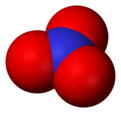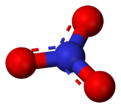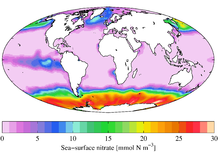
Nitrate
Background to the schools Wikipedia
SOS Children offer a complete download of this selection for schools for use on schools intranets. Visit the SOS Children website at http://www.soschildren.org/
| Nitrate | |
|---|---|
 |
|
 |
 |
|
Nitrate |
|
| Properties | |
| Molecular formula | NO− 3 |
| Molar mass | 62.0049 g mol-1 |
| Except where noted otherwise, data are given for materials in their standard state (at 25 °C, 100 kPa) | |
| Infobox references | |
Nitrate is a polyatomic ion with the molecular formula NO3− and a molecular mass of 62.0049 g/mol. Nitrates also describe the organic functional group RONO2. These nitrate esters are a specialized class of explosives.
Structure
The anion is the conjugate base of nitric acid, consisting of one central nitrogen atom surrounded by three identically bonded oxygen atoms in a trigonal planar arrangement. The nitrate ion carries a formal charge of -1. This results from a combination formal charge in which each of the three oxygens carries a −2⁄3 charge, whereas the nitrogen carries a +1 charge, all these adding up to formal charge of the polyatomic nitrate ion. This arrangement is commonly used as an example of resonance. Like the isoelectronic carbonate ion, the nitrate ion can be represented by resonance structures:
Properties
Almost all inorganic nitrate salts are soluble in water at standard temperature and pressure. A common example of an inorganic nitrate salt is potassium nitrate (saltpeter).
Occurrence
Nitrate salts are found naturally on earth as large deposits, particularly of Chile saltpeter a major source of sodium nitrate.
Nitrites are produced by a number of species of nitrifying bacteria, and the nitrate compounds for gunpowder (see this topic for more) were historically produced, in the absence of mineral nitrate sources, by means of various fermentation processes using urine and dung.
Uses
Nitrates are mainly produced for use as fertilizers in agriculture because of their high solubility and biodegradability. The main nitrates are ammonium, sodium, potassium, and calcium salts. Several million kilograms are produced annually for this purpose.
Other uses
The second major application of nitrates as oxidizing agents, most notably in explosives where the rapid oxidation of carbon compounds liberates large volumes of gases (see Gunpowder for an example). Sodium nitrate is used to remove air bubbles from molten glass and some ceramics. Mixtures of the molten salt are used to harden some metals.
Detection
Free nitrate ions in solution can be detected by a nitrate ion selective electrode. Such electrodes analogously to the pH selective electrode. This response is partially described by the Nernst equation.
Toxicity
Toxicosis
Nitrate toxicosis can occur through enterohepatic metabolism of nitrate to nitrite being an intermediate. Nitrites oxidize the iron atoms in hemoglobin from ferrous iron (2+) to ferric iron (3+), rendering it unable to carry oxygen. This process can lead to generalized lack of oxygen in organ tissue and a dangerous condition called methemoglobinemia. Although nitrite converts to ammonia, if there is more nitrite than can be converted, the animal slowly suffers from a lack of oxygen.
Human health effects
Humans are subject to nitrate toxicity, with infants being especially vulnerable to methemoglobinemia due to nitrate metabolizing triglycerides present at higher concentrations than at other stages of development. Methemoglobinemia in infants is known as blue baby syndrome. Although nitrates in drinking water were once thought to be a contributing factor, there are now significant scientific doubts as to whether there is a causal link. Blue baby syndrome is now thought to be the product of a number of factors, which can include any factor that causes gastric upset, such as diarrhoeal infection, protein intolerance, heavy metal toxicity etc., with nitrates playing a minor role. Nitrates, if a factor in a specific case, would most often be ingested by infants in high nitrate drinking water. However, nitrate exposure may also occur if eating, for instance, vegetables containing high levels of nitrate. Lettuce may contain elevated nitrate under growth conditions such as reduced sunlight, undersupply of the essential micronutrients molybdenum (Mo) and iron (Fe), or high concentrations of nitrate due to reduced assimilation of nitrate in the plant. High levels of nitrate fertilization also contribute to elevated levels of nitrate in the harvested plant.
Some adults can be more susceptible to the effects of nitrate than others. The methemoglobin reductase enzyme may be under-produced or absent in certain people that have an inherited mutation. Such individuals cannot break down methemoglobin as rapidly as those that do have the enzyme, leading to increased circulating levels of methemoglobin (the implication being that their blood is not as oxygen-rich). Those with insufficient stomach acid (including some vegetarians and vegans) may also be at risk. It is the increased consumption of green, leafy vegetables that typically accompany these types of diets may lead to increased nitrate intake. A wide variety of medical conditions, including food allergies, asthma, hepatitis, and gallstones may be linked with low stomach acid; these individuals may also be highly sensitive to the effects of nitrate.
Methemoglobinemia can be treated with methylene blue, which reduces ferric iron (3+) in affected blood cells back to ferrous iron (2+).
Marine toxicity
In freshwater or estuarine systems close to land, nitrate can reach high levels that can potentially cause the death of fish. While nitrate is much less toxic than ammonia, levels over 30 ppm of nitrate can inhibit growth, impair the immune system and cause stress in some aquatic species. However, in light of inherent problems with past protocols on acute nitrate toxicity experiments, the extent of nitrate toxicity has been the subject of recent debate.
In most cases of excess nitrate concentrations in aquatic systems, the primary source is surface runoff from agricultural or landscaped areas that have received excess nitrate fertilizer. This is called eutrophication and can lead to algae blooms. As well as leading to water anoxia and dead zones, these blooms may cause other changes to ecosystem function, favouring some groups of organisms over others. As a consequence, as nitrate forms a component of total dissolved solids, they are widely used as an indicator of water quality.
Nitrate also is a by-product of septic systems. To be specific, it is a naturally occurring chemical that is left after the breakdown or decomposition of animal or human waste. Water quality may also be affected through ground water resources that have a high number of septic systems in a watershed. Septics leach down into ground water resources or aquifers and supply nearby bodies of water. Lakes that rely on ground water are often affected by nitrification through this process.
Nitrate in drinking water at levels above the national standard poses an immediate threat to young children. Excessive levels can result in a condition known as " blue baby syndrome". If untreated, the condition can be fatal. Boiling water contaminated with nitrate increases the nitrate concentration and the potential risk.
Nitrate toxicity in livestock
Nitrate poisoning is a concern for cattle producers primarily, but also for other ruminant growers. Nitrate is naturally consumed by growing plants; however when growth is interrupted, the roots of plants will continue to take up nitrate from soil, and unless new plant growth occurs, the nitrate will accumulate. Thus, harvesting after nitrate buildup results in a crop that is high in nitrates. Factors that can cause nitrate buildup in plants are frost, hail damage, drought, hot dry winds, pesticide damage, herbicide damage and any other plant stunting environmental causes.
Symptoms of nitrate poisoning include increased heart rate and respiration; in advanced cases blood and tissue may turn a blue or brown colour. Feed can be tested for nitrate; treatment consists of supplementing or substituting existing supplies with lower nitrate material. Safe levels of nitrate for various types of livestock are as follows:
| Category | %NO3 | %NO3-N | %KNO3 | Effects |
|---|---|---|---|---|
| 1 | <0.5 | <0.12 | <0.81 | Generally safe for beef cattle and sheep |
| 2 | 0.5-1.0 | 0.12-0.23 | 0.81-1.63 | Caution - some subclinical symptoms may appear in pregnant horses, sheep and beef cattle |
| 3 | 1.0 | 0.23 | 1.63 | High nitrate problems - death losses and abortions can occur in beef cattle and sheep |
| 4 | <1.23 | <0.28 | <2.00 | Maximum safe level for horses. Do not feed high nitrate forages to pregnant mares |
The values above are on a dry (moisture free) basis.
Nitrate overview
| HNO3 | He | |||||||||||||||||
| LiNO3 | Be(NO3)2 | B(NO3)3 | C | N | O | F | Ne | |||||||||||
| NaNO3 | Mg(NO3)2 | Al(NO3)3 | Si | P | S | ClONO2 | Ar | |||||||||||
| KNO3 | Ca(NO3)2 | Sc(NO3)3 | Ti | V | Cr(NO3)3 | Mn(NO3)2 | Fe(NO3)3 | Co(NO3)2 | Ni(NO3)2 | Cu(NO3)2 | Zn(NO3)2 | Ga | Ge | As | Se | Br | Kr | |
| RbNO3 | Sr(NO3)2 | Y | Zr | Nb | Mo | Tc | Ru | Rh | Pd(NO3)2 | AgNO3 | Cd(NO3)2 | In | Sn | Sb | Te | CI | Xe | |
| CsNO3 | Ba(NO3)2 | Hf | Ta | W | Re | Os | Ir | Pt | Au | Hg(NO3)2 | Tl | Pb(NO3)2 | Bi | Po | At | Rn | ||
| Fr | Ra | Rf | Db | Sg | Bh | Hs | Mt | Ds | Rg | Uub | Uut | Uuq | Uup | Uuh | Uus | Uuo | ||
| ↓ | ||||||||||||||||||
| La | Ce | Pr | Nd | Pm | Sm | Eu | Gd(NO3)3 | Tb | Dy | Ho | Er | Tm | Yb | Lu | ||||
| Ac | Th | Pa | UO2(NO3)2 | Np | Pu | Am | Cm | Bk | Cf | Es | Fm | Md | No | Lr | ||||





